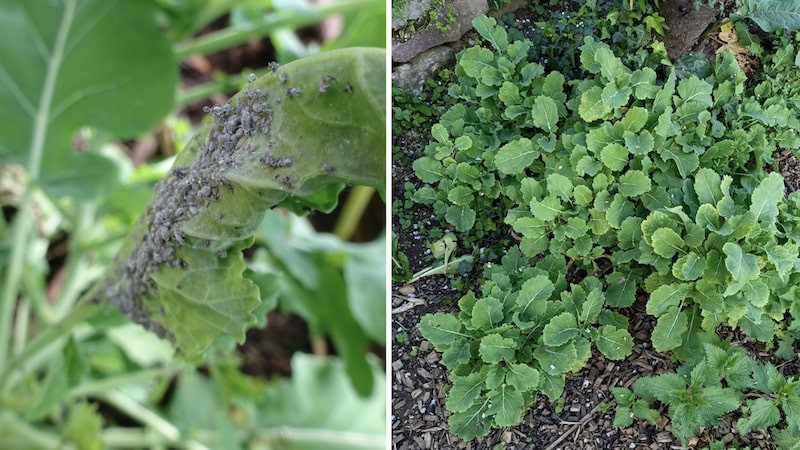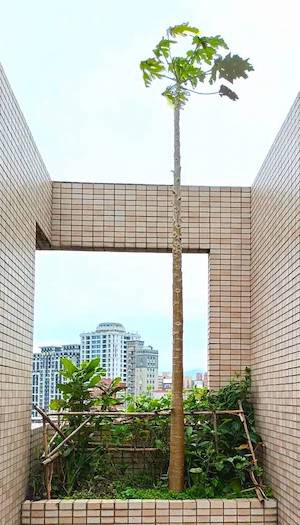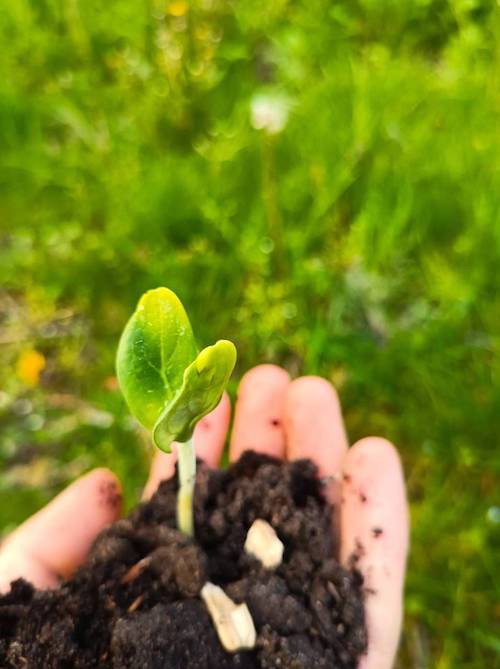Observing a tiny ecosystem to better immerse into ecology, philosophy, and spirituality

I originally published this article in French on the webzine Vibre Magazine. It is the 3rd episode of a series of 4 articles on planting a tiny food forest on the balcony.
I often lack patience when gardening.
I design my micro-forest eagerly, following natural principles, as in the 1st episode. I prepare my soil with passion, installing plants without hesitation, as in the 2nd episode. Step by step, very quickly, everything is prepared!
Then, as soon as I’ve finished planting, I come back every hour to check on the growth. But nothing moves… Suddenly, everything is so slow… Oh dear, at this speed, when will I be able to harvest?
Often, my enthusiasm clashes with the slow, inertial, powerful rhythms of nature. In despair, I have no choice but to observe, patiently.
And so, what unfolds before my eyes in this tiny forest garden is a complex interweaving of precise processes, a perpetual motion full of mysteries.
Out of the boredom emerge profound lessons about nature and about myself, an invitation to reposition my relationship with the ecosystem and living things…
But, you may wonder, what lessons could 5 or 6 vegetables scattered in a tiny planter teach us? Let’s take a closer look at what I mean!
Table of Content
An infinity of details reveal themselves in our growing micro forest garden
Once everything is planted, we can start watching our vegetables grow!
The leaves of the kale are dark green, while those of the tomato are lighter. But are the leaves of the same plant always of the same shade? The stem of a tomato is hairy, while that of a basil is square! What about other plants? Basil flowers smell so good. But what does a ginger flower smell like?
Oh, just after sunrise, a bee comes to pick all the kale flowers, one by one. By the way, do bees forage in the afternoon too? Perpetual leeks taste stronger than supermarket leeks. But is the taste the same all along the leek leaf? And at the foot of the leek, strange tiny insects are busy on the ground of my little forest. What exactly are they doing?
Oh, by the way, I’ll take this opportunity to check if my soil is well-shaded by foliage and covered with decomposing matter. Is it still a little cool and damp, like in a forest?
Despite the smallness of a micro-garden, so many details reveal themselves to the exploring eyes.
These details could easily escape us. But if we take the time to observe them, they teach us an enormous amount about vegetable families, plants, insects, soil, ecological principles, cycles, and nature.
Isn’t this knowledge, which we acquire directly by observing the phenomena around us, even more precise and valuable than that which we can acquire from books?
Moreover, such a habit of connecting directly to the present leads us to practice, without realizing it, a fundamental teaching found in all spiritualities: the presence. The present moment, here and now, contemplation, mindfulness, observing reality as it is.
Yes, gardening - even a tiny garden - is an unexpected gateway to the heart of the spiritual life!
But isn’t it a bit of a waste of time to spend all that time observing instead of acting? I’m not so sure…
To act or not to act?
As I patiently and carefully observe the hairs on the stems of my tomato plants, I’m shocked to notice strange little shoots covering the ground just below my tomato plant. Oh, no, “weeds”, I thought! Hoping to prevent them from suffocating my tomato plant in the future, I’m already frantically pulling them out, one by one…
By the way, what were those little weeds?
Future dandelions? Baby plantains? Nettles? Yarrow? If it was one of these common weeds, then I wasted time reacting so quickly before observing. After all, all these herbs are edible, and all of them even have medicinal properties! If these plants are developing so well, perhaps this shows me that there were still some rays of sunlight left unused by my vegetables? When the same plant grows in large numbers over a small area, it can even be promoted from “weed” to the more honorable status of “bio-indicator plant”. In other words, its presence will indicate unbalanced soil. Too wet? Too dry? Too rich in nitrogen? Too compacted?
Later, after these wild grasses have produced biomass, kept the soil more moist, and revealed all this information about the quality of my soil, I can either eat them, or recycle them back into the soil. All this with no seeds to buy, and very little work on my side!
There are very detailed books on how to identify plants, find out if they’re edible, and understand what their presence can tell us about our soil. But a very simple way to start identifying plants is to use a smartphone application.
For example, I often use PlantNet.
Having now understood that I can save a lot of time by doing nothing but observing, I set about exploring my tiny garden, armed with my smartphone to identify spontaneous herbs…
But, as I lovingly observe all these crazy seedlings growing spontaneously, I am shocked to discover that a tribe of insects is colonizing the stems of my sweet potato and even starting to snack on the leaves. Oh, no, “pests”, I thought! Hoping to save a few leaves, a moment later I’m already crushing them, one by one…
But then again, could I have done nothing and observed before acting?
Insects are an integral part of nature and of our balcony micro-forest. They perform crucial functions such as decomposing plant debris, enriching the soil with their excrement, and stirring and aerating the soil. Some, known as “auxiliaries”, pollinate for us, or regulate the populations of other greedy insects.
As with plants, there are smartphone applications to help identify insects! I still don’t use them frequently, but I know Picture Insect, for example.
It’s true that other insects feast on some of the leaves of our vegetables, but isn’t this a fair reward for their fertilizing work? And when a tribe of greedy insects devours an entire plant, you begin to suspect: is it better to react quickly to exterminate them, or is it better to observe them and try to gather valuable information? Was the plant already sick and weak? Was it going to perish sooner or later? Is it really adapted to my climate and soil? Is it genetically modified?

My perennial cabbage gets eaten by aphids in autumn. I just sit back and watch… It is back with even more vitality in the spring!
We often interpret natural processes as good or bad, and react spontaneously by trying to control or correct them, instead of simply observing them. We think we save time by acting quickly, but in the end, we can waste a lot of it!
A quote from the Taoist sage and philosopher Lao Tzu sums it all up with elegance: “Not to act is to act; to act is not to act”.
So, while gardening is a highly spiritual activity that invites us to be here and now, it is also an invitation to a better understanding of enigmatic and profound philosophical teachings!
But then, should I never act at all?
Let’s dare to experiment
Sometimes, stunned and confused as we are, witnessing the collapse of ecosystems, we come to isolate natural areas in an attempt to protect them from human destruction, we come to no longer dare to act for fear of doing something wrong. After all, as we’ve just seen, every little natural phenomenon has its reasons, which we often ignore, and nature doesn’t need us to function properly.
However, it seems to me that we can also find an intermediate position, by remembering the famous fourth principle I proposed in the first article of this series: disturbances. Nature is dynamic, and ecosystems undergo endless natural disturbances, such as fires, storms, and herbivores, which constantly renew them.
A more balanced approach would be to continue to act, but with awareness.
For example, I don’t weed because “we need to get rid of the weeds”, but because “I’ve decided not to keep these weeds this time, even if they might be edible”. Or, I crush all those little insects, not “because they’re pests”, but because “I want to try to save my sweet potato plant, even though I know I haven’t yet figured out what’s behind this sudden colonization of greedy insects”.
Sometimes we have to make a decision, we have to act, but we can do so with awareness, while acknowledging our ignorance.
Nature is also about luxuriance, movement, creativity, liveliness, and joy! So why not continue to mimic nature, experimenting with joy and curiosity with whatever comes to mind?
For example, I’ve heard that vegetables shouldn’t be planted too close to each other, so that they don’t compete for water, light, and nutrients. But is it always true? Why not check it our myself?
I’ve also heard that you can replant the head of a pineapple. Does this really really work? Does the new plant produce pineapples? And why not try it with the heads of carrots, radishes, etc.?
And then, if I manage to keep my soil moist and cool all the time, why not try introducing button mushroom debris? Will the mycelium filaments develop into balcony mushrooms?
And why not plant some trees? After all, we want to create a forest!
What would be the fate of an apple or lemon seed that has started to germinate, if I sow it in the middle of my micro-forest?
I’d also like to try, for example, an oak tree, whose acorns found in the forest in autumn germinate very easily, and whose foliage is edible. Or a willow, whose cuttings root very easily…

In Taiwan, a papaya tree volunteered between our vegetables, in our urban rooftop garden.
Communicating with plants?
You see, if I encourage you to observe and experiment, it’s not just because it’s a way of learning a lot about nature quickly. Instead of acting like a gardening CEO, or a micro-forest manager, who would decide how things should be without really trying to understand the ecosystem, we gain humility by observing first, acting more gently, realizing how much a micro-ecosystem has to teach us.
Then, just when we might be inclined to stop ourselves from acting, for fear of doing something stupid, perhaps out of guilt, we remember that nature is in constant disruption, dynamic, joyful, playful; that our experiments are also part of nature, and that our trials are also a form of disruption.
The result is a more harmonious, simpler, more spontaneous posture. Neither above nor below the ecosystem, but rather as equals. I’m a part of nature, and cultivating my micro-garden begins to feel like teamwork between the ecosystem and me, a collaboration, an exchange, a dance.
But this idea of an exchange, a discussion between the ecosystem and myself, is not just a metaphor.
Take Don José Carmen, the Mexican farmer who, in the 80s, heard plants talking to him and telling him how to take care of them. By following their advice, he was able to grow enormous vegetables. A friend told me that today in France, certain mediums communicate with plant devas, the spirits of plants, to help gardeners and farmers who wish to take better care of their crops. And then there are the Indian farmers who meditate in their fields to increase their yields. I’ve dedicated a short article on my blog to this subject!
To my great regret, at the moment, I can’t hear the plants whispering in my ear to tell me how I can take better care of them! So, in the meantime, I observe… I suggest experiments to them, then I observe their responses…
This series of articles on the edible balcony micro-forest will soon be over. But we still have one last episode, where we explore the many, many functions that a micro balcony forest garden can have, more than just food production!
Cheers ;)

Did you like this article?
Great! Then, you may also like to read the next episode of this series, to discover 8 ideas of micro balcony garden forests.
